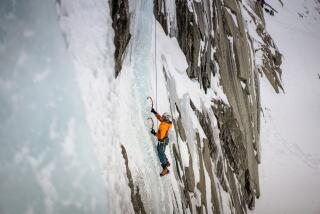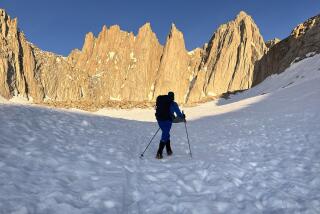Science / Medicine : MOUNTAIN OF THE BIG CHILL : Weather on New Hampshire’s Mt. Washington is so consistently bad that the site is a cold climate testing laboratory for science and technology.
MT. WASHINGTON, N.H. — When it blows, snows, rains or turns foggy on this rocky, 6,288-foot high New England summit, science pays rapt attention.
Whipped by reputedly the hardest winds on Earth, this “stormiest mountain in the world” is besieged by a unique combination of weather forces. As a result, the peak, highest in the northeastern United States, has been a premier cold weather testing laboratory for science and technology for more than a century.
Now it may figure prominently in determining a number of significant matters, including whether the Earth is experiencing a warming or “greenhouse” trend, the best way to keep power lines free of ice and how best to keep track of ozone levels in the atmosphere.
With a splendid view into five states, a corner of Canada and the Atlantic Ocean (on rare cloudless days), Mt. Washington is the reigning monarch of the Presidential Range of New Hampshire’s White Mountains, favorite of skiers, hikers and naturalists. It is located at a point where three storm tracks converge, bringing chilly, blustery, Arctic-like weather--sometimes with very little warning--even in midsummer.
When residents of the nearby village of Gorham swelter in muggy midsummer heat, they need only drive eight miles up the twisting Mt. Washington Toll Road or ride a steam cog railway to encounter a radically different climate on the summit.
Twenty feet of snow falls on Mt. Washington in an average year; in the 1968-69 winter, nearly 48 feet was measured. The year-round temperature average is below freezing, and only once did the temperature exceed 70 degrees. In 1934, the mercury plummeted to 47 degrees below zero.
But it is the wind that makes Mt. Washington a favorite topic for discussion among climatologists and helps to shape the conditions that the Pentagon found ideal during World War II to test everything from tires to sleeping bags to fog-piercing searchlights for its Arctic-bound troops.
Year-round, the wind blows at an average gale-strength 35 m.p.h. It exceeds hurricane strength a third of the time. And for a few minutes on April 12, 1934, anemometers at the Mt. Washington Observatory recorded steady winds of 231 m.p.h.--the strongest ever measured anywhere.
“I remember one night when it blew 187 m.p.h.,” said Kenneth Rancourt, a meteorologist on the summit for seven years. “Those are the times you don’t dare go outside.”
Along the toll road from New Hampshire 16 to the summit, a visitor climbs about a mile in elevation. But as evidenced by the change in vegetation and weather, that is the equivalent of moving north in latitude--at the same theoretical elevation--about 1,000 miles. Coupled with the extremes of climate, this geographic quirk has made Mt. Washington an ideal place to study the effect of arctic and sub-arctic conditions on humans and machines as well as flora and fauna without leaving the comfort and convenience of New England.
One phenomenon on the summit whose study has figured importantly into military and commercial aviation is rime ice. A scientific puzzle for decades, rime ice forms when super-cooled droplets of moisture in the atmosphere (those below freezing temperature but inexplicably still liquid) freeze once they touch a solid object, such as a building or an airplane. “Rime ice is beautiful to look at on the mountaintop,” Rancourt said, “but it’s downright life-threatening on an aircraft.”
Ice adds dangerous weight to an aircraft. It can destroy aerodynamics when it forms on a wing and it makes maneuverability impossible when it freezes on control surfaces. When the jet age arrived with its much speedier aircraft, a reliable way to keep ice from forming was clearly needed. Mt. Washington, with its overly generous supply, became the world’s premier testing site for de-icing technology.
Heat seemed the most logical solution. “But melting the ice required more energy than aircraft could generate,” Rancourt said, “so a boot de-icer--a plastic-covered device fitted on the leading edge of the wing, perfected on Mt. Washington--became the aviation industry de-icing standard.”
Rainmaking was a natural spinoff from the de-icing studies. Irving Langmuir and Vincent Schaefer of the General Electric Co. came here to perfect their technique of seeding clouds that contained super-cooled water droplets, causing rain.
Riding the crest of scientific enthusiasm whipped up by the Mideast oil crisis, Mt. Washington in the 1970s became a busy test site for wind-driven alternative energy devices. Another New England mountain, Grandpa’s Knob in Vermont, is where wind turbine research actually started; Mt. Washington is where many successful turbines in commercial use today were perfected.
But it wasn’t easy. Early on, Mt. Washington scientists learned to their dismay that, too often, winds here blew too hard, destroying the test devices. “Another problem,” noted geologist William Lowell Putnam in his appropriately titled book, “The Worst Weather on Earth,” “was that too much of the energy generated had to be pumped back into the turbine to keep it clear of ice.”
Weather observations have been maintained here since 1871 when the Army Signal Corps established a small observatory. The present, nonprofit observatory was founded in 1932 and has compiled weather records every three hours since 1933. The observatory crew leads a hermit-like existence in winter, being resupplied weekly by a specially designed, tracked snow vehicle. Closed to the public in winter, the summit once was called the “City in the Clouds,” boasting an elegant hotel, a telegraph office, even a newspaper. All were destroyed in a fire in 1908.
Scientifically speaking, Mt. Washington has never been busier. In one current project, the University of New Hampshire, under contract to the Army, is testing ways to keep power lines free of ice. This technology, Rancourt pointed out, may have commercial spinoffs “such as finding ways to keep ice from hampering the operations of fishing trawlers.
Conditions on the summit, he said, also make the site ideal for monitoring cosmic rays and measuring ozone levels in the atmosphere. Cosmic rays--lethal rays, some of which originate millions of light years away--are filtered out by the Earth’s atmosphere. They have been studied here since the 1930s.
A final ongoing program on the mountain will attempt to relate changes in Mt. Washington vegetation to long-term or short-term changes in global climate and temperature. Funded by the National Oceanic and Atmospheric Administration, the research will be conducted by a team led by Dr. Barrett Rock, a forest resource professor at the University of New Hampshire.
Rock hopes to combine on-site observations in five Mt. Washington vegetation zones with historic aerial photographs and satellite imagery. “I have no doubt we’ll find changes in the vegetation,” Rock said. “The problem lies in relating them to climate change.”
As Rock explained, if there have been marked changes in the patterns of vegetation here over the past half-century--approximately the period that the mountain has been photographed from the air--the information could figure into the controversial global warming, “greenhouse” theory. He considers Mt. Washington an ideal site for the work because forests here have few known plant diseases and are not prone to insect damage. “So whatever changes we find,” he said, “presumably will be those caused only by climate change.”
Rock is particularly interested in Mt. Washington’s “ecotones”--the transitions between the vegetation zones found at varying levels on the mountain. Of special interest is the Mt. Washington “krummholz” (crooked wood)--where spruce, firs and other trees perhaps a century old may grow only 18 inches high because of the harsh weather.
If the study turns up irrefutable evidence that the globe is indeed warming because of human influences such as forest clearing and industrial pollution, “perhaps our data will goad someone into taking action before it’s too late,” Rock said.
New Hampshire’s Mt. Washington:
* If offers one of the world’s severest combinations of wind, cold, ice and storms that is accessible to humans for repeated measurement.
* The summit lies in the path of the principal storm tracks and air mass routes affecting the northeastern United States.
Also affecting the weather:
* The White Mountains run north-south, almost perpendicular to the direction of prevailing west and west-northwest winds.
* Because of the peak’s elevation, it is ecologically similar to the subarctic zone.
1. Storm track moving in from Ohio Valley in Midwest.
2. Storm pattern coming from area of St. Lawrence River in Canada.
3. Storm pattern heading in from Atlantic Ocean.
Mt. Washington Facts:
* Height: 6,288 feet
* Location: Near Gorham, N.H., in the Presidential Range of White Mountains.
* Latitude: 44 degrees, 16 minutes N.
* Longitude: 71 degrees, 18 minutes W.
* Weather: Harsh conditions most of the year, approximating those usually encountered at a much higher altitude. Over the years, more than 100 people have died on its slopes.
* Background: Used as a natural laboratory for cloud physics research and for development and testing of instruments, aircraft components and structures required to withstand high winds and icing conditions.
* Highest recorded wind: 231 m.p.h.
* Wind: Exceeds hurricane speeds of 75 m.p.h. an average of 104 days a year.
* Average annual snowfall: 244.7 inches.
NORMAL, AVERAGE AND EXTREMES IN JANUARY AND JULY
Precipitation (in inches) JANUARY Normal rainfall: 7.3” Record monthly snowfall over 24 hours (1978): 24” JULY Normal rainfall: 6.9” Record monthly snowfall over 24 hours (1957): 1.1”
Wind Speed (In miles per hour) JANUARY Average speed: 46.1 Peak gust in 1985: 173 JULY Average speed: 25.3 Peak gust in 1933: 110
Temperature JANUARY Normal low: -3.3 Normal high: 13.4 JULY Normal low: 42.9 Normal high: 54.4
Temperature Records JANUARY Record low temperature, 1934: -47 Record high temperature, 1950: 44 JULY Record low temperature, 1982: 25 Record high temperature, 1953: 71
More to Read
Sign up for Essential California
The most important California stories and recommendations in your inbox every morning.
You may occasionally receive promotional content from the Los Angeles Times.










